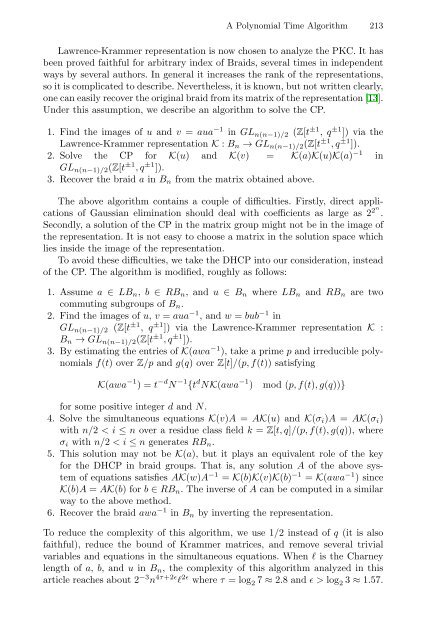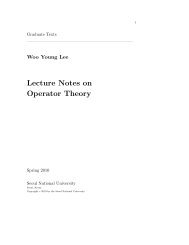A Polynomial Time Algorithm for the Braid Diffie-Hellman Conjugacy ...
A Polynomial Time Algorithm for the Braid Diffie-Hellman Conjugacy ...
A Polynomial Time Algorithm for the Braid Diffie-Hellman Conjugacy ...
You also want an ePaper? Increase the reach of your titles
YUMPU automatically turns print PDFs into web optimized ePapers that Google loves.
A <strong>Polynomial</strong> <strong>Time</strong> <strong>Algorithm</strong> 213<br />
Lawrence-Krammer representation is now chosen to analyze <strong>the</strong> PKC. It has<br />
been proved faithful <strong>for</strong> arbitrary index of <strong>Braid</strong>s, several times in independent<br />
ways by several authors. In general it increases <strong>the</strong> rank of <strong>the</strong> representations,<br />
so it is complicated to describe. Never<strong>the</strong>less, it is known, but not written clearly,<br />
one can easily recover <strong>the</strong> original braid from its matrix of <strong>the</strong> representation [13].<br />
Under this assumption, we describe an algorithm to solve <strong>the</strong> CP.<br />
1. Find <strong>the</strong> images of u and v = aua −1 in GL n(n−1)/2 (Z[t ±1 , q ±1 ]) via <strong>the</strong><br />
Lawrence-Krammer representation K : B n → GL n(n−1)/2 (Z[t ±1 ,q ±1 ]).<br />
2. Solve <strong>the</strong> CP <strong>for</strong> K(u) and K(v) = K(a)K(u)K(a) −1 in<br />
GL n(n−1)/2 (Z[t ±1 ,q ±1 ]).<br />
3. Recover <strong>the</strong> braid a in B n from <strong>the</strong> matrix obtained above.<br />
The above algorithm contains a couple of difficulties. Firstly, direct applications<br />
of Gaussian elimination should deal with coefficients as large as 2 2n .<br />
Secondly, a solution of <strong>the</strong> CP in <strong>the</strong> matrix group might not be in <strong>the</strong> image of<br />
<strong>the</strong> representation. It is not easy to choose a matrix in <strong>the</strong> solution space which<br />
lies inside <strong>the</strong> image of <strong>the</strong> representation.<br />
To avoid <strong>the</strong>se difficulties, we take <strong>the</strong> DHCP into our consideration, instead<br />
of <strong>the</strong> CP. The algorithm is modified, roughly as follows:<br />
1. Assume a ∈ LB n , b ∈ RB n , and u ∈ B n where LB n and RB n are two<br />
commuting subgroups of B n .<br />
2. Find <strong>the</strong> images of u, v = aua −1 , and w = bub −1 in<br />
GL n(n−1)/2 (Z[t ±1 , q ±1 ]) via <strong>the</strong> Lawrence-Krammer representation K :<br />
B n → GL n(n−1)/2 (Z[t ±1 ,q ±1 ]).<br />
3. By estimating <strong>the</strong> entries of K(awa −1 ), take a prime p and irreducible polynomials<br />
f(t) over Z/p and g(q) over Z[t]/(p, f(t)) satisfying<br />
K(awa −1 )=t −d N −1 {t d NK(awa −1 )<br />
mod (p, f(t),g(q))}<br />
<strong>for</strong> some positive integer d and N.<br />
4. Solve <strong>the</strong> simultaneous equations K(v)A = AK(u) and K(σ i )A = AK(σ i )<br />
with n/2













